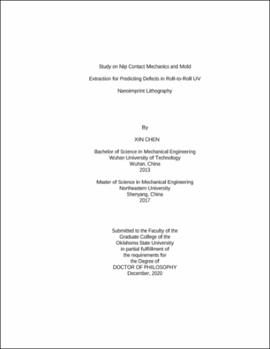| dc.contributor.advisor | Good, James Keith | |
| dc.contributor.author | Chen, Xin | |
| dc.date.accessioned | 2021-05-25T20:32:24Z | |
| dc.date.available | 2021-05-25T20:32:24Z | |
| dc.date.issued | 2020-12 | |
| dc.identifier.uri | https://hdl.handle.net/11244/329948 | |
| dc.description.abstract | Nano-scale or micro-scale structured surfaces have been proven fundamental for high-performance microelectronics. With the development of the microelectronics market, there is an increasing demand for higher-performance, smaller size, energy-saving products. Roll-to-roll nanoimprint lithography (R2R UV NIL) provides possibilities for the mass production of nanoimprinted surfaces. In the process line, the coated web passes one or more nip sets which are formed by a rigid roller and a rubber roller. The nip mechanics have proven that the nip contact would induce an increase in the web tension, which was called nip-induced tension (NIT). Under some conditions, this increase of web tension causes slippage between the imprint roller and the resin which distort or destroy the nanofeatures. Additionally, the successful extraction of imprints from molds on imprint rollers is also an important facet of the R2R UV NIL process. Nanofeatures that fracture during the extraction leaves an imperfection in the imprinted surface and the residual may cause an imperfection that repeats with each revolution of the imprint roller. Internal stresses within the imprinted features increase and can exceed the strength of the cured resin which would result in fracture of the feature and an imperfection in the imprinted surface. The objective of this research is to develop simulation tools that can predict whether defect-free nanofeatures will be produced or not. This will enable UV NIL manufacturing to move from a trial-and-error approach to a predictive mode where defect-free processes can be determined prior to moving to the manufacturing industry. Manufacturers of UV resins typically will provide their estimates of shrinkage, tensile strength, and modulus properties for their resin. The simulation tools include a macro-scale and a nano-scale numerical models. The first model is developed to predict the slippage in the whole pattern of the R2R NIL processes, while the second one is established to predict the quality of the extraction process. Most of the properties needed for simulations of the UV curable resin system employed in the current project are unknown prior to this work. Methods for characterizing the properties of the UV resin will either be developed or adopted from standards. | |
| dc.format | application/pdf | |
| dc.language | en_US | |
| dc.rights | Copyright is held by the author who has granted the Oklahoma State University Library the non-exclusive right to share this material in its institutional repository. Contact Digital Library Services at lib-dls@okstate.edu or 405-744-9161 for the permission policy on the use, reproduction or distribution of this material. | |
| dc.title | Study on nip contact mechanics and mold extraction for predicting defects in roll-to-roll UV nanoimprint lithography | |
| dc.contributor.committeeMember | Wang, Shuodao | |
| dc.contributor.committeeMember | Azoug, Aurelie | |
| dc.contributor.committeeMember | Emerson, Robert | |
| osu.filename | Chen_okstate_0664D_16947.pdf | |
| osu.accesstype | Open Access | |
| dc.type.genre | Dissertation | |
| dc.type.material | Text | |
| dc.subject.keywords | adhesive characterization | |
| dc.subject.keywords | contact mechanics | |
| dc.subject.keywords | finite element analysis | |
| dc.subject.keywords | mold extraction | |
| dc.subject.keywords | roll-to-roll | |
| dc.subject.keywords | uv nanoimprint lithography | |
| thesis.degree.discipline | Mechanical and Aerospace Engineering | |
| thesis.degree.grantor | Oklahoma State University | |
